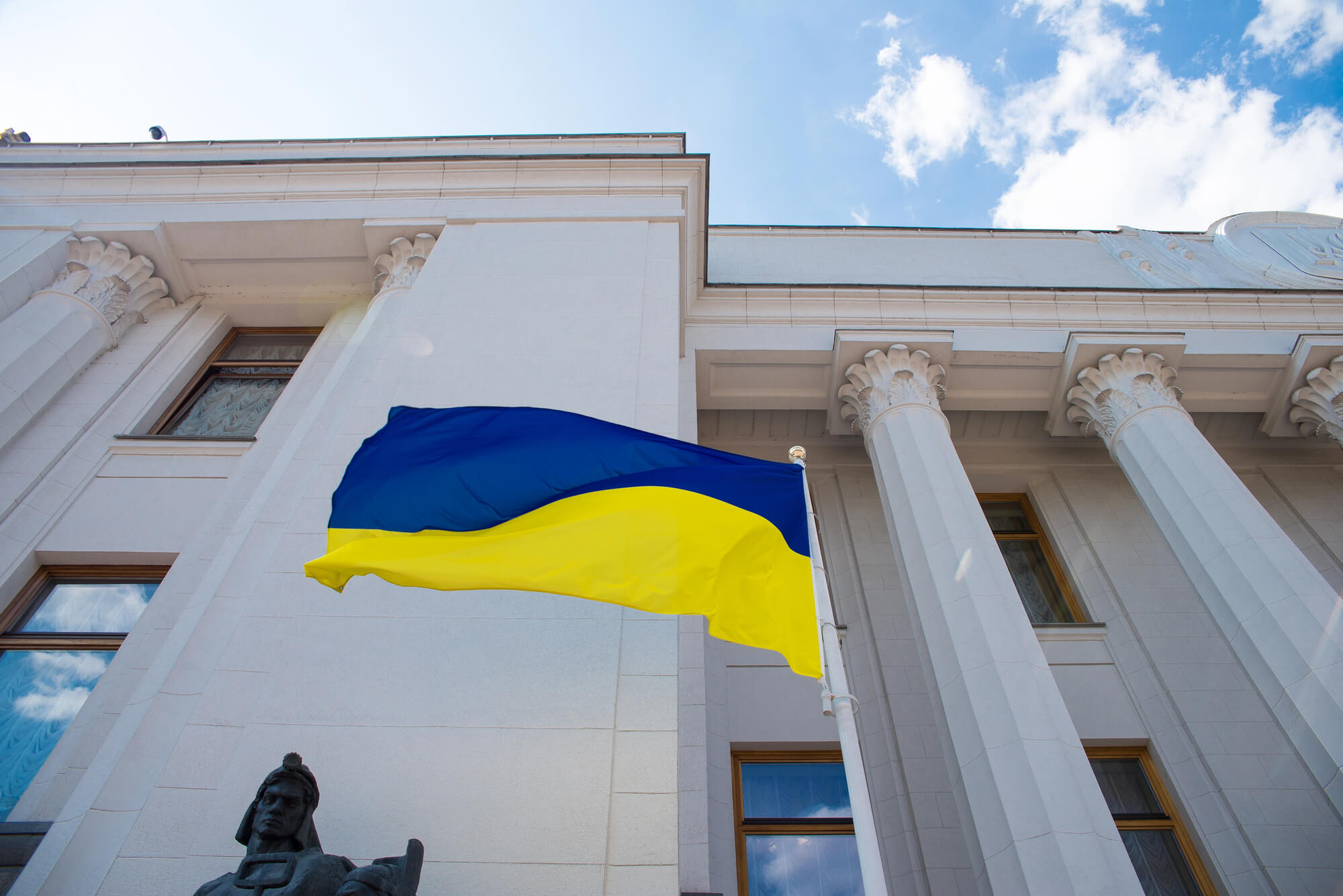After a long pause, mass demonstrations reappeared in Ukrainians’ lives. On July 22, the Verkhovna Rada passed Law No. 4555 (Bill No. 12414), which limited the independence of NABU and SAPO. In response, protests broke out across Ukrainian cities. About a week later, on July 31, the Verkhovna Rada voted for a new bill that canceled part of Law No. 4555’s provisions. The protests ended.
In the media, descriptions of the protesters ranged from positive (“a young generation that feels the value of the state and its institutions“) to negative (“paid students,” “people who don’t work and don’t pay taxes“). Yet we know very little about who actually took part. Aside from a few interviews with individual protesters (for example this, this and this), photographs of people holding cardboard signs remained almost the only source of insight into the motives and makeup of the movement. Still, those photos most likely highlight the more creative or provocative slogans, as well as the more colorful and probably younger participants. As a result, they may give a somewhat distorted picture of who went out to protest and why.
What we did
To answer the question “who exactly came out and why,” we ran a survey of protesters using a short questionnaire. It took place from 7:30 p.m. to 10:10 p.m. on July 30 at Ivan Franko Square in Kyiv—one day before the planned session of the Verkhovna Rada, where several draft laws on the powers of NABU and SAPO were to be considered. We picked that date because a big rally was scheduled at 8:00 p.m. on Ivan Franko Square, and people were being actively called to show up. The next day’s vote in the Rada was set for daytime, when many would be at work, so July 30 was expected to draw the largest crowd. The survey was done face-to-face with paper questionnaires among people aged 18 and over. We only talked to adults (18+) since interviewing minors would require parental or guardian consent, which cannot realistically be obtained at a protest. The interviews were carried out by KSE University students.
Survey Details
The selection of respondents combined two stages adapted to the location. First, we surveyed people at the entrances to the square, systematically selecting participants at intervals of 6 to 15, depending on the intensity of the flow. Later, once the protesters had gathered in, interviewers worked within the square itself. At this stage, each interviewer was assigned a section of the square along which they surveyed protesters every 10 physical steps. We conducted the survey in two stages to make the most of the limited time of the rally, and also in case of a large crowding that would make it impossible to conduct surveys in the denser areas of the square. By selecting people at fixed intervals, we sought to reduce biases caused by the interviewer’s personal preferences (for example, favoring friendlier or more “convenient” rally participants).
As a result, we collected 387 questionnaires. Additionally, we offered protesters flyers with a link to an online survey, whose questionnaire was identical to the paper version. This added eight more responses to the dataset. Seven interviews were conducted with journalists or foreigners, so they were excluded from the dataset. The final dataset consists of 388 responses. The data, questionnaire, and a more detailed description of the study methodology can be found at the provided link. We remind readers that when using this data or materials from this publication, a citation of the source is mandatory.
Age, gender, and employment of protest participants
Women made up the majority in the sample—56.7% compared to 43.3% men (Figure 1).
The age distribution (Figure 2) points to the youthful character of the protest, even though we surveyed only individuals aged 18 and older. By our estimates, up to 5% of those present were under 18. The largest groups were those aged 18–24 (40.4%) and 25–34 (31.9%), who together made up more than 70% of participants. People aged 35–44 accounted for 16.8%, while older cohorts represented only a small share. The median age of respondents was 27—meaning that half of the protesters on July 30 were people who were still in school during the Euromaidan.
The professional structure of the protest (Figure 3) only partly confirms its “student” character: 27.4% of protesters over 18 were enrolled in higher education institutions, while about three-quarters (74.9%) were employed (including some students). The choice of 8 p.m. as the start time of the rally therefore gave them greater opportunity to join after the working day. The share of active-duty members of the Armed Forces was small (2.6%), though it is perhaps more remarkable that, despite service restrictions, they were able to attend at all. The combined share of those who reported neither working nor serving (including students, retirees, people on parental leave, and those with caregiving responsibilities) amounted to 20.4%. In other words, only a minority of protesters were outside the labor market—contradicting the media narrative of “unemployed protesters.”
For comparison, at the Maidan-meeting of 2013 the average age was 36 (with 38% of participants younger than 30), and men predominated (56% versus 44% women). At Franko Square, we see the opposite—a predominance of women (Figure 1) and a much higher share of young people. Students were more than twice as numerous in the July protest (27.4% versus 12% at the Maidan-meeting), while pensioners and the unemployed were minimally represented. This makes the July protest distinctly “younger” and “more female” compared to the Maidan protests. This difference can likely be explained by the wartime context: some men are serving in the Armed Forces, and others may avoid mass gatherings out of fear of being mobilized. The predominance of participants under 25 can also be linked to mobilization policy—since conscription begins at that age—as well as to young people’s strong commitment to democratic values and their intolerance of corruption against the backdrop of disillusionment with the state of democracy (Tamilina, 2024).
The majority of participants in the July 30 protest had also come out during the first days, July 22–23—68.8% attended on at least one of those days (42.4% on July 22, 63.4% on July 23). The final day did not significantly expand the protest: only 17.8% were “new faces” (Figure 4).
After it became known on July 23–24 that a vote on an alternative bill had been scheduled, a debate arose among the protesters. Some called for daily demonstrations until the vote, to maintain public pressure and prevent the protest from fading. Others argued for concentrating efforts on the key date—the day before the vote (July 30). Supporters of the latter tactic were accused by critics of trying to “drain the protest.”
We can see that both camps had a significant share of participants:
- A third of participants (33%) belonged to the active core who attended the protest for four days or more (including July 30). Of these, 7.9% reported joining the rally on all six days.
- 25.9% came on July 22 or 23 and returned on the 30th, skipping July 24–26.
Motives of the protesters
We asked protesters an open-ended question: “How would you formulate the purpose of your participation in these gatherings in one sentence?” The open responses were coded through the ChatGPT platform using the GPT-5 model. With this tool, we identified the primary themes of responses, coded the dataset, and carried out an initial check of the coding (here is the full dialogue with the chat). The final naming of themes and the verification of coding were done manually. A respondent’s answer could be assigned to several themes at once.
The protest’s agenda was not crystallized around one or two leading issues: none of them accounted for even more than a quarter of responses, and the range of motives turned out to be quite diverse (Table 1).
The most frequent theme was the independence of the anti-corruption institutions—NABU and SAPO (21.4%), expressed directly in demands to “restore independence” or “protect anti-corruption bodies from the authorities.”
The second most common group of motives concerned the visibility of the protest and mutual support (15.8%) (“we must show that we are many,” “to support people who are defending rights in our country“), as well as the expression of civic stance (14.2%) (“so that I am heard,” “to show that I care,” “if not me—then who“).
The third group of motives, mentioned by roughly one in ten participants, centered on preventing the usurpation of power and authoritarianism (11.3%) (“not to allow the creation of an authoritarian state,” “against usurpation and dictatorship“), along with more pragmatic motives—demanding changes to legislation (10.0%) and maintaining pressure on the authorities (9.5%) (“to show the authorities that the people are against their decisions,” “to show the authorities that this is not acceptable“).
Somewhat less frequently, participants referred to protesting against corruption as such (7.4%) (“I want to live in a state without corruption,” “to break the backbone of Ukrainian corruption“), as well as emotional motives—anger, fatigue, or anxiety (6.1%) (“We are tired of enduring the authorities spitting in the people’s faces,” “our patience ran out when state institutions were being destroyed,” “they cannot treat us this way“).
Orientations toward broader values and long-term perspectives were less common: European integration and the obligation to carry out reforms (5.3%) (“to preserve the path to the EU,” “so that the authorities follow a pro-European course in actions, not just in words“); a focus on the future (5.3%) (“to have a free country for my children,” “struggle for a better life!“); defending justice and the rule of law (5.0%) (“for a state governed by law,” “to restore justice“); dissatisfaction with the actions or decisions of the authorities (5.0%) (“a protest against the authorities’ wrongful actions: illegal and corrupt,” “not to let the authorities make a mistake“); and the struggle for democracy (4.5%) (“to stop the spread of authoritarianism in Ukraine in opposition to democracy,” “the rule of law, democratic institutions, democratic development of the country,” “to show that Ukrainians are the power and that they are being denied a path to a democratic future“).
We coded a response as “Dissatisfaction with the decisions/actions of the authorities” when the respondent explicitly mentioned dissatisfaction with the authorities’ decisions or actions, rather than with the actions of particular officials. We coded a response as “Struggle for democracy” when the respondent explicitly mentioned a struggle for, or defense of, democracy or democratic values. We do not know what each respondent personally meant by the word “democracy,” nor whether they believe that the democratic order in Ukraine is under threat. For this reason, we did not merge this theme with “struggle against authoritarianism.”
A smaller share mentioned dissatisfaction with the authorities as such (2.9%) (“disagreement with the current authorities,” “a personal protest against the President’s actions,” “to express dissatisfaction with Zelenskyy’s leadership style“), a demand for transparency (1.8%) (“to achieve openness of government and transparency in decision-making,” “to convey the people’s demand for democratic and transparent institutions“), dissatisfaction with the procedure by which the law was adopted (1.6%) (“I protest against unconstitutional amendments and restrictions on NABU and SAPO, the passing of the law outside of procedure,” “I condemn the way this vote was conducted“), and simply “came to take a look” (1.6%).
Although the same motives remained at the top across all age groups—defending the independence of anti-corruption institutions, demonstrating one’s civic stance, and showing solidarity with fellow protesters—there were some differences. Older participants (35+) mentioned less frequently than younger groups the independence of anti-corruption institutions (17.8% versus 23.0% among 18–24 and 22.9% among 25–34), their own civic stance (10.3% versus 15.8% and 15.3%), and the specific demand to change the law (5.6% versus 11.2% and 12.7%).
By contrast, among protesters older than 35, motives such as preventing usurpation and authoritarianism were more common (15.0% versus 7.9% in the 18–24 group), as were a focus on the future (9.3% versus 5.3% in the 18–24 group and 1.7% in the 25–34 group) and dissatisfaction with the authorities as such (5.6% versus 1.3% in the 18–24 group and 1.7% in the 25–34 group).
The 25–34 age group, more than others, emphasized applying pressure on the authorities (14.4% versus 7.2% among 18–24 and 7.5% among those 35+).
Table 1. Purpose of participation in the protest in the overall sample and by age groups
| Overall sample (N=379) | 18–24 years (N=152) | 25–34 years (N=118) | 35+ years (N=107) | |
| Independence of anti-corruption institutions (NABU/SAPO) | 21.4% | 23.0% | 22.9% | 17.8% |
| Visibility of the protest and mutual support | 15.8% | 16.4% | 16.1% | 14.0% |
| Expression of civic stance | 14.2% | 15.8% | 15.3% | 10.3% |
| Prevention of usurpation and authoritarianism | 11.3% | 7.9% | 12.7% | 15.0% |
| Demand for legislative change | 10.0% | 11.2% | 12.7% | 5.6% |
| Pressure on the authorities | 9.5% | 7.2% | 14.4% | 7.5% |
| Protest against corruption | 7.4% | 7.2% | 6.8% | 8.4% |
| Emotional response: anger, fatigue, anxiety | 6.1% | 6.6% | 5.9% | 5.6% |
| European integration and commitment to reforms | 5.3% | 7.2% | 3.4% | 4.7% |
| Orientation toward the future (children, economy, staying in the country) | 5.3% | 5.3% | 1.7% | 9.3% |
| Defending justice and the rule of law | 5.0% | 5.3% | 5.1% | 4.7% |
| Dissatisfaction with the decisions/actions of the authorities | 5.0% | 2.6% | 6.8% | 6.5% |
| Struggle for democracy | 4.5% | 4.6% | 3.4% | 5.6% |
| Dissatisfaction with the authorities as such | 2.9% | 1.3% | 1.7% | 5.6% |
| Demand for transparency | 1.8% | 3.3% | 0.8% | 0.9% |
| Dissatisfaction with the procedure of adopting the law | 1.6% | 2.0% | 0.0% | 2.8% |
| Came to look around and decide what to do next | 1.6% | 0.7% | 1.7% | 2.8% |
| Other | 5.0% | 3.9% | 5.9% | 5.6% |
Note: The themes are sorted in descending order by percentage in the overall sample. A single respondent’s answer could be assigned to multiple themes, so the total within each column may exceed 100%.
What’s wrong with Law No. 12414?
What exactly did protesters dislike about the law? In an additional online survey, we asked participants who had indicated that Bill No. 12414 concerned them the open-ended question: “Which specific provisions cause you concern?” The survey was conducted from July 29 to 31 among members of the Telegram group “Peaceful Assembly 👉 People with Cardboards | Kyiv” (around 2,500 participants), which was moderated by the protest coordinators. We collected 74 responses from people who had joined the rally on at least one day between July 22 and 31 (published here). The themes and corresponding quotes (see Table 2) were identified through the ChatGPT platform using the GPT-5 model. We do not claim that these responses reflect the position of protesters as a whole. We treat these data qualitatively, as illustrations of the reasons for disagreement with the law voiced by the protesters themselves.
Concerns were raised about how well the rally participants actually understood what they were protesting against. From the open-ended responses, we can say that at least some of them were quite well informed about the legislative process, the content, and the consequences of the law—respondents provided fairly detailed and substantive answers. At the same time, there were also shorter and more abstract replies (“fear,” “subordination,” “authoritarianism,” etc.). As Table 2 shows, protesters were troubled both by the substance of the amendments to the law and by their implications for international relations, as well as by the very procedure through which the law was adopted.
Table 2. Provisions of Law No. 12414 that cause concern: quotes from protesters’ responses
| Theme | Corresponding quotes |
| Expansion of the Prosecutor General’s procedural powers | “The Prosecutor General will have the right to demand any NABU case and transfer it to another prosecutor for review,” “Only the Prosecutor General will be able to sign notices of suspicion in NABU cases,” “A direct provision is added granting the Prosecutor General the right to consider motions to close all criminal proceedings against top officials (a list of positions) and, accordingly, to close such proceedings as a result of reviewing the motions.” |
| Concentration of power and risks of authoritarianism | “It is frightening that power is being usurped by a narrow circle of people,” “The concentration of power in the Presidential Office (de facto authoritarianism) by taking control of NABU and SAPO, and allowing certain bodies to conduct searches without a court warrant,” “Authoritarianism.” |
| Corruption risks and selective justice | “Creating a potential mechanism for covering up corruption by allowing the Prosecutor General to take over cases,” “The principle of ‘everything for friends, the law for enemies’ is spreading, which largely undermines and puts EU integration on hold,” “In short—corruption kills☹️“ |
| Searches without a court warrant and procedural risks | “The possibility for law enforcement bodies to enter homes without a court decision,” “The ability of law enforcement to enter a suspect’s home without a warrant,” “The right for police to conduct searches without a warrant.” |
| European integration and international consequences | “…that will not only lead to the demotivation of the population, but also halts reforms on the path toward the EU,” “SAPO is one of the seven requirements for EU accession, and the authorities are waging a coordinated fight against anti-corruption institutions,” “Obstructing EU accession and restricting financial assistance from partners.” |
| Instrumentalization of the law on missing persons | “This law was supposed to be about the missing,” “The way the bill was submitted—the way they distorted the original content related to missing persons,” “Stripping SAPO and NABU of their independence—and the disgust at the fact that this was inserted into the law on missing persons.” |
| Violation of adoption procedure and lack of transparency | “It was adopted in a single day without transparency or proper discussion,” “Violation of parliamentary protocol and the absence of public debate,” “The very fact of such rapid adoption and signing, the dismantling of the independence of anti-corruption bodies, and searches without a court decision.” |
What prompted people to join?
The decision to protest is an individual choice, but it usually requires a certain “push.” We asked participants what specifically prompted them to come (Figure 6). The most common answers were public calls in the media, by bloggers, and in protest communities (50.3%), followed by posts from acquaintances on social media (30.4%) and direct invitations from relatives and friends (16.8%). Less frequently mentioned were belonging to organized groups (11.8%), the example of those who had protested earlier (10.7%), personal initiative (8.1%), and a spontaneous decision on the spot (2.9%).
Thus, the majority of participants in the July 30 protest were mobilized by media triggers—public appeals in the media, posts by bloggers, and messages in protest communities—as well as posts from acquaintances on social media. The second most important channel was interpersonal ties—direct invitations from relatives and friends, or the example of those who had already taken part. Only a minority came through formal organizations such as parties, civic associations, or other groups. This structure confirms that the protest was primarily a network-based, rather than an organizational, mobilization.
Limitations of the study
We sought to maintain a systematic approach in selecting respondents at each stage of the study in order to minimize sampling bias among adult participants of the July 30 protest on Ivan Franko Square. At the same time, the survey was conducted within a dynamic crowd, over a short time frame, and under unfavorable weather conditions. Interviewers received only a brief training and had no prior fieldwork experience. As a result, the procedure for selecting participants at fixed intervals may not always have been followed precisely.
The survey was conducted on July 30. The motivations and composition of protest participants on other days may have differed. Although the fate of the vote on the law restoring the powers of NABU and SAPO remained uncertain on that day, some protesters who had come out in the first days may have been satisfied with the President’s assurances that the independence of anti-corruption institutions would be restored. This is reflected in the noticeably smaller number of participants compared to July 23 (the second day of protests). The July 30 rally took place on a Wednesday evening in rainy weather, so it is likely that those who came that day were the most motivated participants.
We asked participants about their purpose for joining the protest through a single open-ended question, requesting that they formulate it in one sentence. The fact that a respondent did not mention a particular motive does not mean that they did not hold it. A participant may have said they came to support NABU, but the underlying reason for this support could be broader and deeper—resistance to authoritarianism, concern about the suspension of EU assistance, disagreement with the procedure by which the law was passed, and so on.
Acknowledgments
We would like to thank Oleksii Sereda for assistance with planning the organization of the study. We are grateful to Tymofii Brik for initiating and financially supporting the study, and to Anna Kokoba and Alina Shmaliuk for their help in organizing the research, as well as to everyone else without whom this survey would not have taken place. We extend special thanks to all 16 KSE University students who volunteered to conduct interviews with the protesters.
Photo: depositphotos.com/ua
Attention
The authors do not work for, consult to, own shares in or receive funding from any company or organization that would benefit from this article, and have no relevant affiliations





